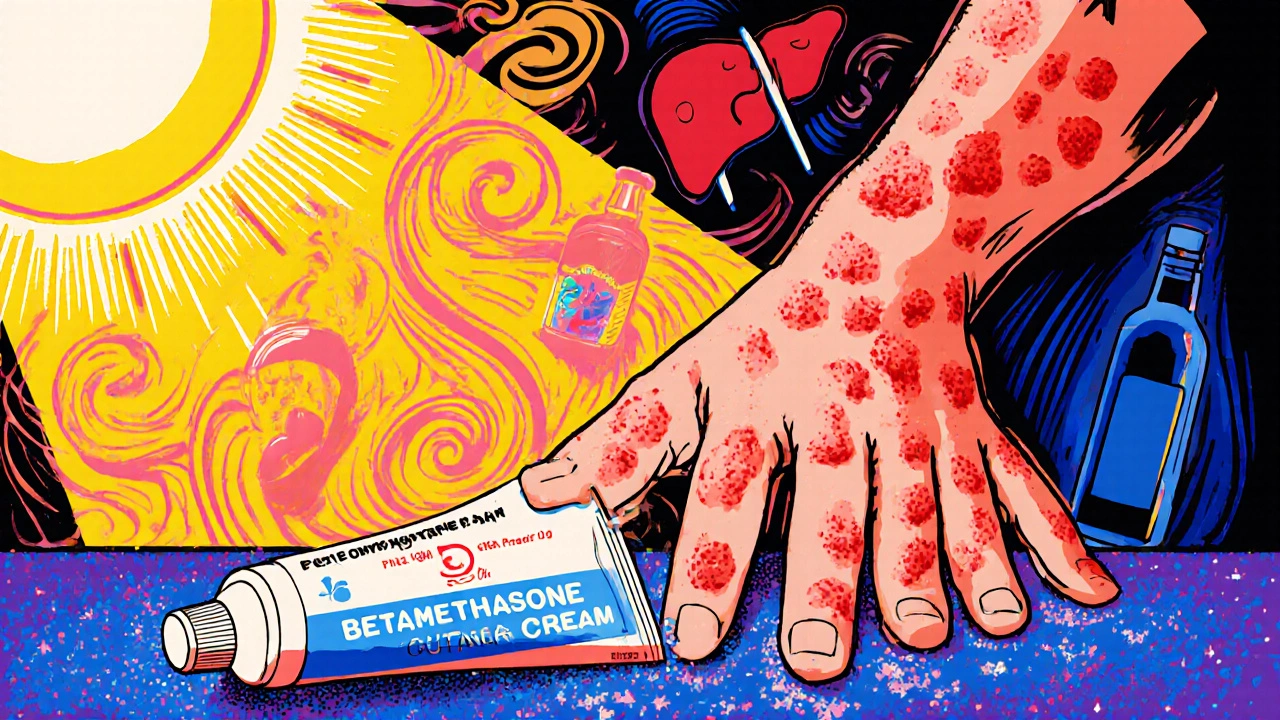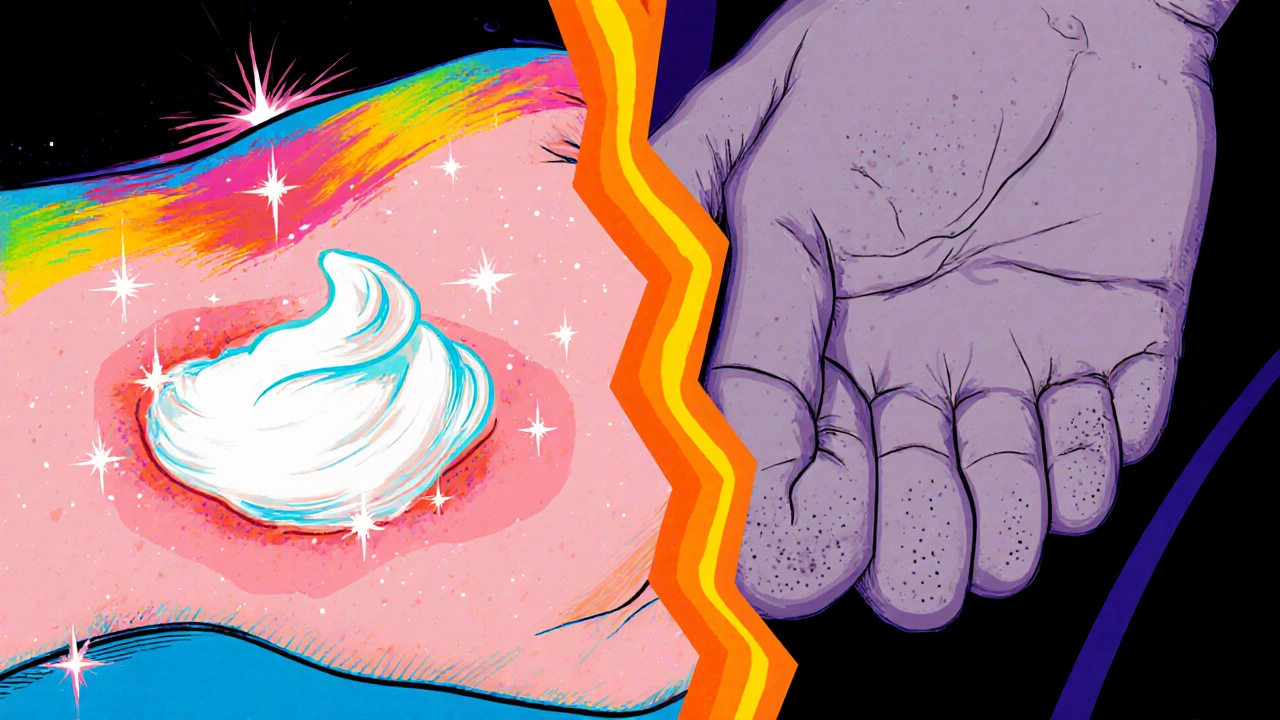Betamethasone for Porphyria Cutanea Tarda Symptoms: Effectiveness and Risks

PCT Steroid Treatment Risk Calculator
This tool estimates the potential benefits and risks of using betamethasone for your PCT symptoms. Based on your inputs, it calculates a risk score to help you and your doctor determine if topical steroids are appropriate for your situation.
Your Treatment Information
People living with porphyria cutanea tarda (PCT) often wonder if a steroid cream like betamethasone can calm the skin eruptions and blisters that come with the disease. The short answer is: it might help a little, but it’s not a cure and it carries its own set of risks. Let’s break down what PCT actually is, how betamethasone works, and what alternatives you should consider before reaching for that tube.
What is Porphyria Cutanea Tarda?
Porphyria Cutanea Tarda is a disorder of the heme biosynthesis pathway that leads to a buildup of uroporphyrins in the skin. The excess pigments make the skin extremely sensitive to sunlight, causing fragile blisters, bullae, and hyperpigmented scars, especially on the backs of hands and forearms. Most cases are linked to a deficiency of the enzyme uroporphyrinogen decarboxylase, often triggered by alcohol, iron overload, estrogen therapy, or hepatitis C infection.
Because the problem originates deep in the liver, skin‑only treatments are only a piece of the puzzle. Managing iron levels, avoiding triggers, and sometimes using medication that reduces porphyrin production are the core strategies.
How Does Betamethasone Work?
Betamethasone is a potent glucocorticoid that reduces inflammation and suppresses immune responses. When applied topically, it penetrates the epidermis, dampening the inflammatory cascade that fuels redness and swelling around PCT blisters.
In theory, a short course of a high‑potency steroid could calm an acute flare, making the lesions less painful and easier to dress. However, the underlying porphyrin buildup remains untouched, so the benefit is purely symptomatic and temporary.
Potential Benefits of Using Betamethasone in PCT
- Rapid reduction of erythema (redness) around new blisters.
- Decreased itching and discomfort, which can improve sleep.
- Convenient over‑the‑counter availability in many pharmacies.
These advantages are most noticeable when the steroid is used for a brief period-usually no longer than two weeks-under dermatologic guidance.

Risks and Drawbacks You Shouldn’t Ignore
- Skin thinning (atrophy) after prolonged use, especially on thin‑skinned areas like the backs of hands.
- Development of steroid‑induced acne or rosacea‑like eruptions.
- Potential worsening of photosensitivity because glucocorticoids can thin the epidermis, making UV penetration easier.
- Systemic absorption is rare but possible with large surface area coverage, leading to HPA‑axis suppression.
If you have a history of eczema or other steroid‑responsive conditions, you might be more prone to these side effects.
Standard PCT Management Strategies
Because the disease stems from the liver’s inability to process porphyrins, doctors usually recommend a combination of the following:
- Low‑iron diet and regular phlebotomy to reduce iron overload.
- Removal of triggers such as alcohol, estrogen, and hepatitis C infection.
- Hydroxychloroquine at low doses (100 mg twice weekly) to mobilize stored porphyrins.
- Sun protection using broad‑spectrum SPF 50+ sunscreen, protective clothing, and avoidance of mid‑day sun.
These interventions address the root cause, whereas betamethasone only masks the surface irritation.
How Betamethasone Stacks Up Against Other Symptomatic Treatments
| Option | Mechanism | Typical Use | Key Risks |
|---|---|---|---|
| Betamethasone | Topical glucocorticoid - anti‑inflammatory | Acute flare, short‑term (<2 weeks) | Skin atrophy, steroid acne, systemic absorption |
| Hydroxychloroquine | Oral antimalarial - mobilizes porphyrins | Long‑term control, 3‑6 months | Retinal toxicity, GI upset |
| Phlebotomy | Therapeutic blood removal - lowers iron | Regular sessions until ferritin < 20 ng/mL | Anemia, venous access issues |
The table shows that betamethasone is the quickest way to calm a flare, but it doesn’t replace the disease‑modifying actions of hydroxychloroquine or phlebotomy.

Practical Tips If You Decide to Try Betamethasone
- Apply a thin layer to the affected area once daily-no more than 0.5 g per hand.
- Limit use to a maximum of 14 days; then switch to a low‑potency steroid or plain emollient.
- Pair with a broad‑spectrum sunscreen (SPF 50+) applied 15 minutes before exposure.
- Monitor for signs of skin thinning: easy bruising, visible veins, or a “paper‑thin” feel.
- Schedule a follow‑up with a dermatologist or hepatologist to track liver function and iron studies.
Following these steps helps you reap the short‑term comfort while keeping long‑term complications at bay.
When to Skip Betamethasone and Seek Alternative Care
If you have any of the following, discuss alternatives with your doctor before reaching for a steroid:
- History of severe skin atrophy or steroid‑induced dermatitis.
- Pregnancy or breastfeeding-systemic absorption could affect the fetus.
- Active infection in the blistered area (e.g., bacterial cellulitis).
- Uncontrolled diabetes, as steroids can raise blood glucose levels.
In these scenarios, low‑dose hydroxychloroquine, meticulous sun avoidance, and iron‑lowering phlebotomy often provide safer, disease‑targeted relief.
Bottom Line: A Short‑Term Fix, Not a Long‑Term Solution
Betamethasone can calm the immediate burning and itching of PCT lesions, but it does nothing for the porphyrin overload that fuels the disease. Use it sparingly, under medical supervision, and always pair it with the core treatments that address iron, trigger avoidance, and porphyrin clearance.
Can I use over‑the‑counter betamethasone without a prescription?
Most high‑potency betamethasone creams require a prescription in the U.S. because of their side‑effect profile. A lower‑strength steroid (like hydrocortisone 1 %) is available OTC, but it’s usually too weak to make a noticeable difference in PCT flare‑ups.
How long should I apply betamethasone for a PCT flare?
Limit treatment to 7‑14 days. Longer use dramatically raises the risk of skin thinning, especially on the thin skin of the hands.
Will betamethasone interfere with phlebotomy or hydroxychloroquine?
There’s no direct pharmacologic interaction, but using a steroid can mask inflammation, making it harder to gauge the effectiveness of your underlying disease‑modifying therapy.
What signs indicate I should stop using betamethasone?
If you notice skin that bruises easily, visible blood vessels, or a persistent burning sensation despite stopping the cream, discontinue use and consult a dermatologist immediately.
Are there natural alternatives to steroids for PCT skin symptoms?
Topical zinc oxide ointments, cool compresses, and rigorous sun protection can soothe mild lesions, but they lack the anti‑inflammatory punch of a steroid. They work best as adjuncts rather than replacements.
Sameer Khan
October 22, 2025 AT 19:17Betamethasone, as a high‑potency glucocorticoid, attenuates the cutaneous inflammatory cascade by modulating NF‑κB signaling and inhibiting prostaglandin synthesis. In the context of Porphyria Cutanea Tarda, this pharmacodynamic effect can transiently reduce erythema and pruritus surrounding acute bullae. However, the etiopathogenesis of PCT resides in hepatic porphyrin overaccumulation, a process untouched by topical corticosteroids. Consequently, the therapeutic window is narrow-typically limited to a two‑week course under dermatologic supervision-to mitigate iatrogenic adverse events such as epidermal atrophy, steroid‑induced acne, and potential photosensitization. Integrating betamethasone should therefore be viewed as an adjunctive measure, not a substitute for systemic iron reduction or hydroxychloroquine therapy.
Tim Blümel
October 29, 2025 AT 16:06Great summary! 👍 The short‑term relief is real, but pairing it with iron‑lowering strategies is key. 🌞🚫
Joanne Ponnappa
November 5, 2025 AT 13:55The article nicely outlines the pros and cons of steroid use for PCT.
Emily Collins
November 12, 2025 AT 11:44I can’t believe anyone would let a thin‑skinned hand suffer the havoc of steroids! The dramatic flare‑ups are enough without adding a culprit that thins the dermis further. It’s a risky gamble that rarely pays off.
Tiffany Davis
November 19, 2025 AT 09:33Indeed, the balance between rapid symptom control and long‑term skin integrity is delicate. A brief, physician‑guided course can ease nocturnal itching, which markedly improves quality of life. Still, patients should be counseled on the importance of concurrently addressing iron overload and UV exposure. Otherwise, the steroid’s benefit is merely a fleeting Band‑Aid.
Don Goodman-Wilson
November 26, 2025 AT 07:22Sure, because slathering potent steroids on fragile skin always ends well.
Tammy Sinz
December 3, 2025 AT 05:12From a mechanistic standpoint, the glucocorticoid receptor complex translocates to the nucleus and suppresses transcription of inflammatory cytokines such as IL‑1β and TNF‑α. In PCT lesions, this can diminish secondary bacterial colonisation and reduce edema. Nonetheless, the pharmacokinetic profile of topical betamethasone limits systemic absorption, making it unsuitable for addressing hepatic porphyrin synthesis. Therefore, clinicians often reserve it for acute exacerbations while maintaining low‑dose hydroxychloroquine to mobilize stored porphyrins. Patient education on strict photoprotection remains the cornerstone of disease control.
Christa Wilson
December 10, 2025 AT 03:01Exactly! 🌟 Combining photoprotection with a brief steroid boost can really smooth things out. Keep the optimism flowing! 😊
John Connolly
December 17, 2025 AT 00:50For anyone considering betamethasone, I’d recommend a patch‑test first to rule out contact dermatitis. Apply a pea‑sized amount to a non‑lesional area for three days and monitor for any adverse reaction. If tolerated, limit use to no more than 10‑15 days, ideally with a tapering schedule. Remember, the systemic side‑effects are rare but not impossible, especially with extensive body‑surface coverage.
Sajeev Menon
December 23, 2025 AT 22:39Thats a solid plan, but dont forget to check iron levels regularily. Definately keep an eye on ferritin trends. Also, a good diet helps keep everything balanced.